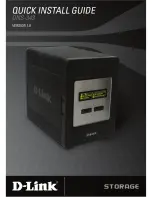
HPE TPM 2.0 installation is supported with specific operating system support such as Microsoft
®
Windows Server
®
2012 R2 and later. For more information about operating system support, see the
product QuickSpecs on the Hewlett Packard Enterprise website (
). For more
information about Microsoft
®
Windows
®
BitLocker Drive Encryption feature, see the Microsoft website
CAUTION:
If the TPM is removed from the original server and powered up on a different server,
data stored in the TPM including keys will be erased.
IMPORTANT:
In UEFI Boot Mode, the HPE TPM 2.0 Gen10 Kit can be configured to operate as
TPM 2.0 (default) or TPM 1.2 on a supported server. In Legacy Boot Mode, the configuration can be
changed between TPM 1.2 and TPM 2.0, but only TPM 1.2 operation is supported.
HPE Trusted Platform Module 2.0 Guidelines
CAUTION:
Always observe the guidelines in this document. Failure to follow these guidelines can
cause hardware damage or halt data access.
Hewlett Packard Enterprise SPECIAL REMINDER:
Before enabling TPM functionality on this system,
you must ensure that your intended use of TPM complies with relevant local laws, regulations and
policies, and approvals or licenses must be obtained if applicable.
For any compliance issues arising from your operation/usage of TPM which violates the above mentioned
requirement, you shall bear all the liabilities wholly and solely. Hewlett Packard Enterprise will not be
responsible for any related liabilities.
When installing or replacing a TPM, observe the following guidelines:
• Do not remove an installed TPM. Once installed, the TPM becomes a permanent part of the system
board.
• When installing or replacing hardware, Hewlett Packard Enterprise service providers cannot enable
the TPM or the encryption technology. For security reasons, only the customer can enable these
features.
• When returning a system board for service replacement, do not remove the TPM from the system
board. When requested, Hewlett Packard Enterprise Service provides a TPM with the spare system
board.
• Any attempt to remove the cover of an installed TPM from the system board can damage the TPM
cover, the TPM, and the system board.
• If the TPM is removed from the original server and powered up on a different server, data stored in the
TPM including keys will be erased.
• When using BitLocker, always retain the recovery key/password. The recovery key/password is
required to complete Recovery Mode after BitLocker detects a possible compromise of system
integrity.
• Hewlett Packard Enterprise is not liable for blocked data access caused by improper TPM use. For
operating instructions, see the TPM documentation or the encryption technology feature
documentation provided by the operating system.
Hardware options installation
71
















































